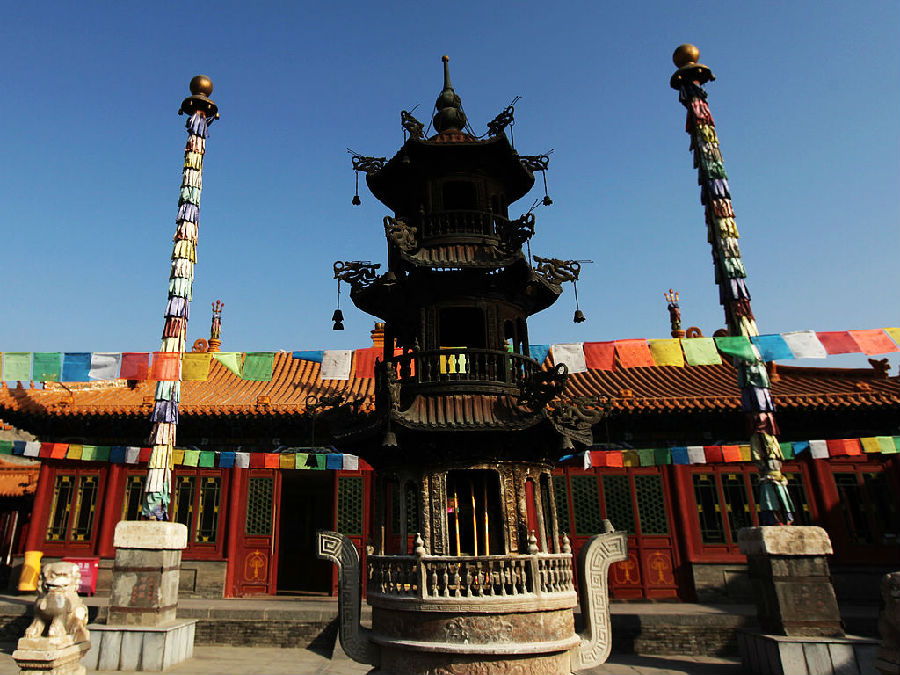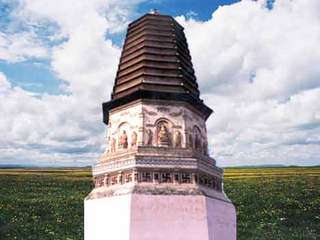主要景点
1.大召寺
Dazhao Temple is in the old city of Hohhot. This is the earliest temple in Hohhot with a history of over 400years. The temple is entirely patterned after Chinese temples except for the main hall,whichis patterned after a Tibetan Lama temple. In the middle of the Buddha hall sits a silver Buddha statute,which provides Dazhao Temple with its alternative name of Silver Buddha Temple.
大召寺位于呼和浩特川城南部,是呼和浩特市建立最早的寺庙,即今已有400年的历史。大召寺院建筑考究,人殿是常见的藏汉式喇嘛庙风格,其余部分则是依照传统中式庙宇的式样而建。佛堂中间立着一座银色佛像。由于寺中供奉银制释迦牟尼像,所以当时也称银佛寺。
Dazhao Temple,‘Wuliang Si(Infinite Temple)'in Chinese .is the oldest building and the largest temple in Hohhot,Inner Mongolia. Locally,people usually refer to it as the Silver Buddha Temple(Ynfo Si)for it is here that there is a rare silver statue of Sakyamuni that measures 2.5-meter-high(8.2-foot-high).
大召寺,又称无量寺。是内蒙古呼和浩特市最古老最宏大的寺庙建筑。当地人通常都称它为银佛寺是因为寺中供奉着高2.5米的释迦牟尼像。

The construction of the temple was tompleted in 1580 during the Ming Dynasty(1368一1644)and it is therefore the oldest Lamaist Buddhist temple in Inner Mongolia. There was a major reconstruction in 1640 although much of the original architectural style was retained.
寺庙的建设于清朝1580年完工,囚此也是内蒙最古老的喇嘛教徒沸教寺庙。在保留原有建筑风格的基础上,该寺又在1640年又进行了重建。
Dazhao Temple owns its fame to a visit by the third Tibetan Dalai Lama in 1586,when he came to dedicate the Silver Buddha statue. As a consequence Hohhot became a religious center for people from all over Mongolia who came to worship at the temple. Another notable event in the temple's long history was a visit by Emperor Kangxi during the early part of the Qing Dynasty(1644一1911).
大召寺因1568年第三代赖喇嘛到此招赠银佛像而出名,结果,呼和浩特就变成了蒙古的宗教中心,人们都前来祭拜。在寺庙悠久的历史上,还有另一个有名的事件,就是清朝皇帝康熙的到访。
The temple is now a well-known tourist attraction because of the impressive buildings,splendid statues delicate trescos,muslcai msiruorema and fine collection of Buddhist scriptures.Of its abundant religious relics perhaps the most notable are the 'Three Marvelous Treasures',a title given to the Silver Buddha,the carved dragons on the huge golden pillars on either side of the statue and commemorating the Emperor's visit.
寺庙现在成为著名的旅游胜地还因为这有令人难忘的建筑、精彩雕像、精美壁画,乐器和收藏完好的佛经。在它许多的宗教遗物中,最著名的或许是“三件珍宝:银佛像、佛像两旁金色柱子上雕刻的龙和皇帝到访时的题词留念。
Except for the main hall,the existing buildings witnin the temple complex are nearly all in the Han style.The main hall is a lamasery combining both Tibetan Han styles of architecture.It has three parts. The front part is a two-story hall with an empty pavilion in the first floor;Jing Tang( the hall for chanting)and Fo Tang(the(the hall for worshiping Buddha)are central andrear sections. The perfectly preserved Silver Buddha lies in Fo Tang as it has for some four hundred years. In the splendid and solemn front of the hall,there is a pair of iron lions with their heads held high.
除了主厅,寺庙内现存的建筑都是汉朝建筑风格。主厅是融合了西藏和汉代建筑风格的喇嘛寺院。它分为三部分,前面的部分是一个两层大厅,在一楼有一个空亭子;经堂和佛堂在中问偏后的位置。银佛像保存完好,被安放在佛堂,已有四百年历史了。大厅的前而辉煌而庄严,立着两个昂首挺胸的石狮子。
2.席力图召(小召)
Xilituzhao Palace is a key cultural protection unit of Inner Mongona mous Region.It is located in the north of Stone Lane,Yuquan District,Hohhot. It isabout 100 meters(328 feet)away from the famous Dazhao Temple. The palace is the largest Lama temple in Hohhot.
席力图召是内蒙古自治区重要的文化保护单位。该召座落在呼和浩旧城玉泉区石头巷北端,座北向南,距离大召寺约100米,它是呼和浩特市内最大的一个喇嘛寺。席力图是蒙古语,意为“首席”或“法座”。
Xilitu,means‘Holy Seat'in Mongolian. It was built in the reign of Emperor Wan Li of Ming Dynasty(1368一1644) for Dalai Lama III and Dalai Lama IV to commemorate the lamas. Xilituzhao Palace was originally quite small,but later on,in the Qing Dynasty(1644一1911),it was renovated and expanded to its present scale.
据史料记载,明万历九年(公元1582年),土默特蒙古部阿勒坦汗死后,其子僧格都楞继承了王位。他执政后,效仿他父亲的作法,决定邀请三世达赖索南坚措到内蒙古子右翼各部传播宗教三世达赖接受了他的邀清为了迎接索南坚措三世达赖的到来,僧格都楞于万历十二年(公元1585年)为他建造了这座小喇嘛庙—席力图召。后来,在康熙、雍正、咸丰和光绪年间,,经不断扩建和修缮.席力图召成为呼和浩特地区规模最大的喇嘛教寺院,并掌握着这个地区的黄教大权。召庙建筑宏敞,风格独具,虽经历了四百年风雨和动乱,仍保留较完整。
The temple was quite grand and unique in architectural style. it remains intact despite being weathered by wind and rain for 400years.The layout of the vuhole architectural complex is the typical traditional Han style. The buildings cover an are a of 5 000 sq meters(5 979 sq yards).The whole architectural complex stands in a symmetrical order. With a mountain gate and a main hall standing in an axis,side halls,storehouses and pavilions,bell and drum towers symmetrically stand in the wings. The main hall consisting of a sutra hall and a Buddha worshiping hall is the main structure of the palace. It is a Tibetan style wooden structure,with walls decorated with colored glazed brick. The roof is covered with green glazed tiles. The Buddha worshiping hall was damaged in a fire though the sutra hall preserves its original condition.
寺庙的建筑风格盛大而独树一帜。尽管被风化了四百年,依然保持原状。整个建筑的整体布局是典型的传统汉式风格这些建筑占地5 000平方米,对称排列,即从山门到大殿形成条中轴线两侧对称布置有侧殿、仓房、碑亭和钟鼓楼。带有藏经堂和拜佛堂的大殿为寺庙的主建筑。这是一个藏式木结构建筑,墙壁用彩色琉璃砖砖镶嵌,屋顶铺设着绿色琉璃瓦。然而,拜佛堂后来被一把大火烧毁,藏经堂却仍保持着原有的风貌。
To the east of the main hall stands a stone pagoda made of white marble,which is the best preserved Lama pagoda of bowl-earthen style in Inner Mongolia Autonomous Region. The pagoda with an average height of i 5 meters ( 49 feet ) is magnificent. Originally,to the northeast of the pagoda。there was a larger temple named Naichun Temple,but unfortunately,it was burnt down in 1887. In front of Xilituzhao is a superb paifang,an archway. The archway across the street stands facing the mountain gate. It is a wooden structure decorated with exquisite colored paintings.
院内东侧傲然屹立着一座汉白玉砌成的覆钵式喇嘛塔,塔的平均高度为15米,很壮观。最初,在塔的东北部,有座更大的寺庙叫乃春庙,但不幸的是,1887年这座庙被烧毁。在席力图召的前面是一个大牌坊。街道有对面有一道拱门l面对山门而立,是用精美绘画修饰的木质建筑。
Xilituzhao Palace is the most exquisite preserved temple in Hohhot The magnificent architecture and splendid colored paintings make the palace a tourist resort. AdditionaAy,many religious activities and Buddhist conference are held here every year.
席力图召是呼和浩特保存完好的一个寺庙,壮现的建筑,精彩的绘画使它成为 一个旅游胜地。另外,每年许多宗教活动和佛教会议都在此举行。
3. Wanbu Huayanjing Pagoda( White Pagoda)
3.万部华言经塔(白塔)

Buiff in the Liao Dynasty(916一1125),the Wanbu Huayanjing(Ten Thousand Huayan Buddhist Scriptures)Pagoda is located in the east suburbs about 17 kilometers(11 miles) from Hohhot City. Legend says that about ten thousand volumes of the Huayan Buddhist Scripture once were kept in the pagoda,hence its name. Due to lts white surface,the pagoda is also called the White Pagoda. In 1982,the Wanbu Huoyanjing Pagoda became a national key cultural relic site.
修建于辽代(916一1125)的万部华言(一万部华言佛经)经塔位于护师郊区东部17公里处。传说此塔因保存着一万部华言佛经而得名。由于外观为白色,故又称白塔。1982年,万部华言经塔被列为国家重点文化遗产。
With a height of 55 meters(180 feet),the Wanbu Huayanjing Pagoda is a seven-tier octagonal brick and wood structure. In order to survive earthquakes,many wooden stakes were wedged in the walls to reinforce the structure. Each story of the pagoda consists of the exterior wall,the interior wall and the cloister between them. A spiral staircase connects the stories together and leads to the top of the pagoda. Bronze mirrors are embedded under the eaves of each side of the pagoda. Wind bells hang on the ceiling of the corner of each story and on the rafter of the seventh tier .Approaching the pagoda,tourists can see the bronze mirrors gleaming under the sun and hear the euphonious sound of the wind bells.
万部华言经塔高55米、是七排八角型砖木结构。为了应对地震,许多木铁砧被楔在墙壁内以加固建筑结构塔的句一而都包括外墙,内墙和两墙之问的回廊。一部螺旋梯把这几面相连,并且通向塔顶。塔各边的房檐下都安装了铜镜,还有风铃挂在每一面角落的天花板和第七排的椽木上。走进塔内,游人就会看到古铜色的镜子在太阳的照射下闪闪发光,听到风铃发出的悦耳的声音。
On the pedestal are carved beautiful lotus petals. The sculptures of Bodhisattvas,Heavenly Kings and other Buddhist figures are embedded on the surface of the walls of the first and the second tiers. These sculptures are considered to be the finest expressions of the sculpturing art in the Liao Dynasty
万部华言经塔基座上雕刻着美丽的莲花花瓣,第、二层墙壁的表面雕刻着菩萨、玉皇大帝和一些佛教人物。人们认为这此雕塑完美地表达了辽代的雕刻艺术。
Each story of the pagoda has two gates. On the door head of the south gate of the first story is embedded a plaque with the inscription,'Wanbu Huayanjing Pagoda'. Originally,nine Jin Dynasty(1115一1234)steles were preserved on the first floor. Only six remain extant today. Inside the pagoda are also preserved some in scriptions of the Jin,Yuan,Ming and Ding Dynasties which are written in Chinese or languages of other ethnic minorities.
塔的每个面都有两扇门。楼南门的门头上挂着一块匾,上面写着“万部经言塔”。起初,九块金代石碑是在一楼保存着的。而如今却只剩下了六块。塔内还保存着金、元、明、清的一些记载资料,用汉语或其他少数民族语言编写而成。
Other Attractions Around the Place
周边名胜
1.格根塔拉草原
Gegentala Grassland is to the north of Hohhot,within the Inner Mongolia Autonomous Region. It is the largest and a unique Mongolian scenic spot bearing the Mongolian ethical features of China. In Mongolian‘Gegentala'means a summer resort or the place of grazing in summer. On the grassland .the weather is cool and the natural scenery is fascinating. With thriving grass and abundant water,the green of the grassland reach out as far as your eyes can see.
格根塔拉草原在内蒙古自治区呼和浩特市北部,是具有中国蒙占族特色的最大且独特的蒙古景点。格根塔拉草原的蒙语意思为“避暑胜地”。在草原上,气候凉爽,自然风景引人人胜。草木生长旺盛,水资源丰富,放眼望去,满眼皆绿。
Colorful wild flowers and flocks of sheep that look like masses of cloud make the scene absolutely beautiful.
多姿多彩的野花和成群的羊儿使风景变得异常优美。
Besides the scenery of Gegentala Grassland,visitors can also taste traditional Mongolian food and take part in local activities. While listening to the melodious toasting songs and appreciating traditional Mongolian dances,visitors have the opportunity to taste kumiss,roasted whole sheep and shouba rou(boiled mutton eaten with hands).In traditional Mongolian clothes,visitors can take part in horse race,wrestling and archery which have been popular in Inner Mongolia for thousands of years. At night,people sit around bonfires singing and dancing to their hearts' content. After one day's travel,the Mongol ger,which means home in Mongolian,provides accommodation for the tourist. All these experiences give visitors the true feeling of what life is like on the vast grassland.
游客除了欣赏格根塔拉草原的风景,还可以品尝传统的蒙古美食,参加当地的民俗活动;除了可以欣赏旋律优美的敬酒歌,还可以欣赏传统的蒙古舞,品尝马奶酒,烤羊肉和手抓羊肉。 游客还可以穿着传统的蒙古服装参加赛马比赛、搏斗和射箭,这些活动在内蒙古地区已经流行了几千年。晚上,人们围坐在簧火旁唱歌跳舞,非常尽兴。结束了一天的旅行,游客可以在蒙古包休息。蒙古包对蒙古人而言就是家。所有这些都让游客真真切切地感受着大草原。
To enrich the tourist experience,modern facilities,such as night clubs and luxurious Mongol gers,have been established. Every July or August when flowers are in full bloom and sheep and horses are in their best condition,a tourism festival called Nadam Fair is held(Nadam Fair means entertainment and amusement in Mongolian. It is a traditional grand meeting and also an annual gala event for the Mongolian).This period is also a favorable season for travel.
为了使游客的经历更加丰富,像夜总会、豪华蒙古包之类的现代娱乐设施已经建立起来。每年七、八月份鲜花盛开时节,也是羊儿、马儿最为膘肥体壮之时。这里会举办极具地方特色的旅游节。这个时期是最适宜来此旅行。
2.希拉穆仁草原
Xilamuren Grassland is a typical altiplano prairie,with exuberant grass and vigorous wildflowers in summer and autumn. Situated 100 kilometers (62miles) from Hohhot,the grassland is also known as Zhaohe because of its Lama Puhui Temple. Behind Puhui Temple flows XilamurenRiver, yellow river in Mongolian. Tourists can go across the bridge to Abinlebao Hill to admire the boundless prairie. Aobao,a stone pile,was originally a land mark in the boundless grassland.As the grassland was far away from mountains,people gradually began to regard aobao as a mountain where they could worship gods. Such worship ceremonies can last several days and are also used as an opportunity for young people to date.The famous folk song Date at aobao may be a product of this custom. It is also said that if you pick up a stone and walk around aobao three times in a clock wise direction,make a wish,and then put the stone back at aobao ,your wish will be fulfilled
希拉穆仁草原是典型的高原草场。每当夏秋时节,绿草如茵,鲜花遍地,一望无际的景色,使人如痴如醉。希拉穆仁草原俗称“召河”,位于呼和浩特市北100公里处,因在希拉穆仁河边有清代喇嘛庙“普会寺”而得名。跨过河上大桥可达阿勒宾敖包山上观赏美丽的草原风光。敖包,是一个石堆,最初是一望尤际人草原的一个地标。因为草原离山很远,渐渐地人们就把敖包当成祭拜天神的山。这种祭拜仪式持续好几天,因此也为年轻人的约会提供了便利。著名歌曲《敖包相会》就是这个习俗的产物。据说,如果你检起一块石头按顺时针方向沿着敖包走三圈,许个愿望,然后把这块石头放回敖包,愿望就会实现。
Xilamuren Grassland is the first grassland tourist attraction opened in Hohhot.Xilamuren,which means ‘yellow water'in Mongolian,is also known as Taihe of ter PuhuiTemple,a Lama temple built in 1769 in the Qing Dynasty(1644一1911).
希拉穆仁草原是呼和浩特第1个向游开放的草原旅游胜地。希拉穆子一的蒙语意思为“黄色的水”。“普会寺”原为呼和浩特席力图召六世活佛的避暑行宫,建于乾隆34年(公元1769年)。
The best time to visit the grassland is in summer and autumn.At this time of year, the pleasant climate,the blue sky and white clouds,the rolling grass,the wandering flocks and herds,the passionate herdsmen and their Mongolian food will undoubtedly leave you with a deep impression. During the Nadam Festival held every summer,tourists can enjoy a series of different activities including camel riding, horse racing,wrestling , archery,a camp fire party and singing and dancing.You can even take part in some of the competitions that you are interested in.
去希拉穆仁草原旅游的最佳时节为夏季和秋季。在这段时间里,气候宜人,蓝天,白云,起伏的青草,漫步的牛羊,热情的牧人和蒙古美食,毫无疑问会给游客留下很深的印象。在一年一度的旅游节上,游客可以体验不同的活动,有骑骆驼、赛马、摔跤、射击、篝火晚会。游客甚至可以参加些自己感兴趣的比赛。














